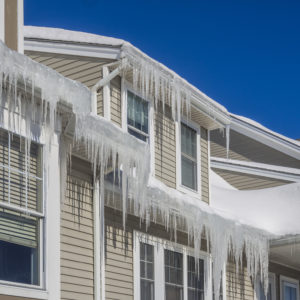This winter has brought below normal temperatures and plenty of snow – which is the perfect recipe for ice backup and collapse concerns. Fortunately, there are some preventative measures you can take to avoid the stress that comes with those winter worries. The first step is understanding the problem.
collapse concerns. Fortunately, there are some preventative measures you can take to avoid the stress that comes with those winter worries. The first step is understanding the problem.
Ice backup forms when rising heat melts snow and ice on an upper part of the roof and the water runs down to the eaves and roofline where it is colder and refreezes. That causes a couple of problems. First, the ice dam prevents water from properly draining off the roof and can cause leaks and water damage inside. Second, as the ice accumulates, it can actually lift up the shingles on the roof, where the ice can melt again, causing the roof sheathing to soak up the water and cause more leaks and damage.
Now that you know, let’s tackle how to remove snow from the roof. Here’s a few tips on how to get the job done safely:
- Clear your roof with a snow rake when possible.
- Always clear the snow in a downward motion to preventing lifting and damaging the shingles.
- Don’t worry about scraping the roof perfectly clean – leave about two inches of snow on the roof to prevent damage to the shingles underneath.
- Remove snow from at least the bottom four feet of the slope and around valleys.
- Be aware of electrical lines, vents and skylights and stay clear of them.
- If using a ladder, make sure the footing is secure.
- If you must get on the roof, move cautiously and use a safety harness on steep slopes to prevent falling. Work with a partner who remains on the ground.
- Stay hydrated and know your limits to prevent back and other physical injuries.
If you are unable to clear your roof, call a professional. Left to accumulate, heavy and uneven snow loads can be dangerous. Keep an eye out for signs of trouble including cracked ceilings, windows, and rafters as well as sagging parts of the roof. Call a qualified contractor to help remove the snow if you notice any of these. Local code enforcement can also help determine if a structure is fatigued due to snow load. Remember, the best way to stay safe and prevent ice backup and snow load issues is to clear your roof and other structures consistently throughout the winter months.